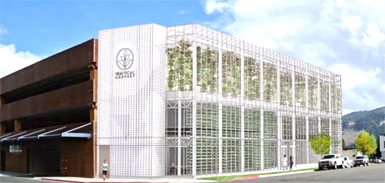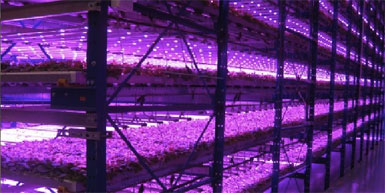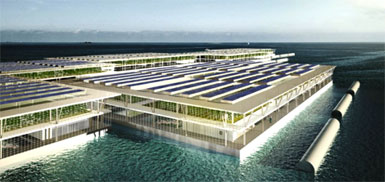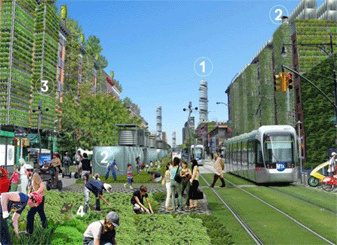by Rona Fried
With years of extreme drought in California and the Midwest bread basket, we’re beginning to see how climate change can have a devastating impact on food supplies and prices.
The silver lining is this could lead us to a more sustainable food system, one that relies on locally produced food and that doesn’t depend on transporting it huge distances (which would lower emissions).
This isn’t pie in the sky – 80-100% of Americans’ food could be grown within 50-100 miles of our homes, concludes Elliott Campbell, a professor at University of California/Merced, in the study, "The Large Potential of Local Croplands to Meet Food Demand in the United States."
Locally produced food isn’t new – we’ve seen an explosion in farmers markets and Community Supported Agriculture (CSAs) in recent years, and the USDA has been fostering local "food hubs,"
but there’s huge room for growth.
30% of New York City’s population could be fed from farms within 100 miles, as could half the people in the greater Los Angeles area, for example. The percentage goes up as people eat more plants and less meat. Compost collected from cities would fertilize the farms, obviating the need for petroleum-based fertilizers, Campbell says.
Local planners would have to prioritize farms and protect them from expanding suburbs, and the crops grown would have to match local growing conditions.
Combined with urban farms and Vertical Farms, we can see a much safer future for feeding the vast, growing human population, most of which will increasingly live in cities.
Vertical Farms
We interviewed the inventor of vertical farms in 2008 when they were considered a fringe idea, but now Dickson Despommier, a Columbia University professor, is seeing them take off around the world.
Imagine growing organic food right in the middle of cities inside where they are protected from drought, floods and disease. Lighting, temperature, humidity and water can all be tweaked to farm very efficiently, resulting in higher yields than outdoor farms.
And importantly, it would greatly reduce agricultures’ outsized environmental footprint. No more gobbling up water supplies; spraying pesticides, petroleum-based fertilizers and equipment, erosion and degradation of carbon absorbing soil, and lots of land could return to wildlife habitat.
Many people are imagining that now – in the past few years, 100 companies have entered the field, according to the Association for Vertical Farming. There are 24 vertical farms in the US.
MIT Media’s Lab’s CityFARM project is working on the research side to develop scalable, productive practices. Its high tech methodology reduces water consumption by 98%, eliminates chemicals and doubles nutrient density, they say. With the advent of affordable LEDs, even round-the-clock lighting is no longer a barrier. GE and Phillips are developing LEDs that generate light in wavelengths that are just right for growing plants.
"By fundamentally rethinking "grow it THERE and eat it HERE" to "grow it HERE and eat it HERE" we will dramatically reduce environmental contamination and depletion while creating jobs for a rapidly urbanizing global workforce and increasing access to diverse and affordable nutrient dense produce in our future cities," MIT says.
Notable Vertical Farms:
FarmedHere (Chicago), sells greens to more than 400 local supermarkets, and is the first USDA Certified Organic aquaponic indoor farm. It reuses almost all water in a 2-story, 90,000 square feet building. The Plant is another farm opening in Chicago next year to grow greens, mushrooms and kombucha in a closed-loop system.
Vertical Harvest (Jackson, Wyoming): in a place covered in snow most of the year, this 3-story, 13,500 square foot space will provide fresh fruit and vegetables all year long. It will open early next year with 95% of products pre-sold to restaurants and grocery stores. It’s being built on a tiny 30X150 spit of land downtown and expects to produce 100,000 pounds of micro-greens and tomatoes a year.
Plants move on a conveyor belt (similar to dry cleaning racks) which ensures they get an equal amount of southern exposure natural light. It also delivers plants to workers for transplanting or harvesting.
"We’re replacing food that was grown in Mexico or California and shipped in. We feel like the community’s really ready for a project like this. Everybody’s so much more aware of the need to reduce transportation, and people like to know their farmer and where food’s coming from," co-founder Penny McBride, told Fast Company.

Ouroboros Farms (Pescadero, California) combines aquaponics with vegetable growing. Catfish swim along the bottom floor, feeding crops above with their nitrogen-rich waste. They sell a wide array of vegetables and fish.
Green Spirit Farms (New Buffalo, Michigan) uses pink-tinted LED lights which allow it to grow 10 tons of produce in just 500 square feet. They grow a variety of greens, tomatoes, carrots, peppers, beets and stevia. The owners are developing an "app" that allows them to remotely adjust nutrient levels and monitor equipment. They are expanding into Ohio and elsewhere.
AeroFarms (Newark, New Jersey): a $30 million renovation is underway to convert a former steel factory to a 69,000 square foot farm. Its backed by Goldman Sachs Urban Investment Group, Prudential Financial and others.
Caliber Biotherapeutics (Bryan, Texas): grows plants for the pharmaceutical industry in an 18-story, 150,000 square foot facility. 2.2 million plants are stacked 50-feet high are used for biotherapies such as vaccines for oncology and global pandemics.

Sky Greens (Singapore): uses sunlight to grow leafy greens and captured rainwater runs a unique pulley system that rotates the plants.
Mirai: (Kyoto, Japan): originally built to provide fresh food after the nuclear meltdown, the company has two vertical farms in Mongolia, one under construction in Hong Kong, and has plans to expand in many other parts of the world.
Plantagon (Linköping, Sweden) is a skyscraper surrounded by decks where vegetables are grown, run on excess heat and carbon from nearby industrial plants.
Concept Farms
Smart Floating Farms: this solar-powered vertical farm floats on pontoons, opening the possibilities for offshore farms in many of the world’s major cities. The modular design allows it to be configured and stacked in various ways. On top are rainwater collectors for irrigation, solar PV panels and skylights that bring in natural light. Fish swim around at the bottom, where there’s also a hatchery and nursery.

Urban Skyfarm is a skyscraper shaped like an enormous tree where lightweight decks provide 24 acres of outdoor growing spaces. The "trunk" is an indoor hydroponic farm, and solar and wind systems on the roof provide the energy. Besides 5000 fruit trees and vegetables, it cleans the air, decreases the urban heat island effect and filters captured rainwater through a constructed wetland. There could be community gardens and a farmers market there.
Urban Farms
In NYC, Hunts Point Cooperative Market is being renovated to accommodate mid-sized farmers from NY State. At this largest wholesale food distribution center in the world, only 4% of the $2.3 billion of food that passes through is local – the rest is from other states and 55 countries, reports the NY Times. Having a wholesale hub for local food will make it easy for NYC’s restaurants to buy organic food. Mid-size farms often fall through the cracks in our distribution system because they are too big for farmer’s markets and too small to compete with agribusinesses.
Finally, West Louisville FoodPort is transforming a "food desert" into one of the largest local food hubs in the US. Built on a 24 acre brownfield in Louisville, Kentucky, "it will co-locate businesses in the local food supply chain, leveraging the assets of each to gain scale and efficiency in aggregating and distributing local food," says the nonprofit, Seed Capital Kentucky, which is developing the project. The farm will run on biogas from food scraps, and compost is a byproduct.
Sited at the border of three low-income neighborhoods, they will be joined by open space that includes a farmers market, the urban farm, and edible gardens. Farmers will be able to sell their entire crop at the hub and start-ups will get help at its incubator.
Chicago is transforming 100 acres of city-owned land from vacant lots into an "urban farm district," and Boston’s ordinance allows urban farms within city limits. Another urban farming pioneer is BrightFarms, and Whole Foods has a greenhouse on the roof of one store.
Read our articles, LEED-Platinum Factory Topped By World’s Largest Urban Farm, How to Feed a Growing Population? Nevada Thinks It Has An Answer, and By 2050, Urban Buildings That Breathe And Adapt.
For more inspiration about the future of cities: Climate Change is Grim, But Future Cities Can Be Verdant:

